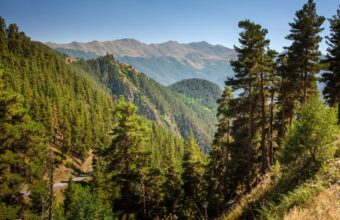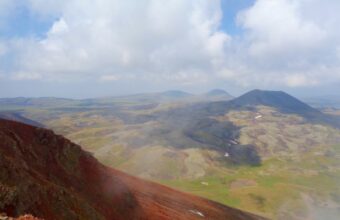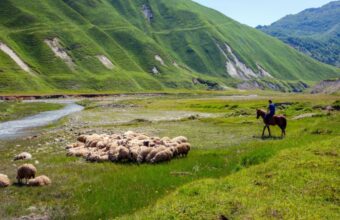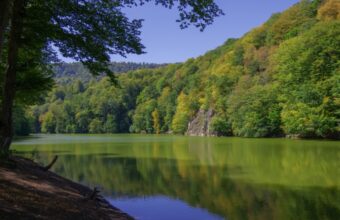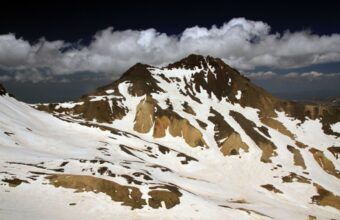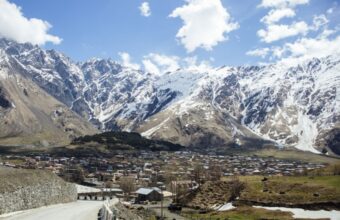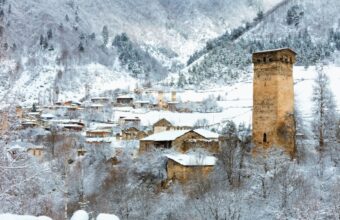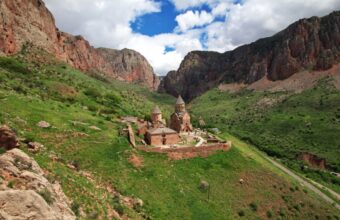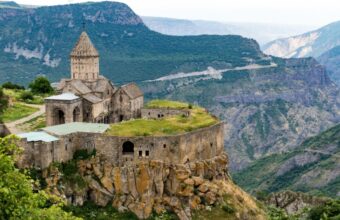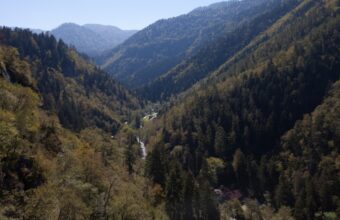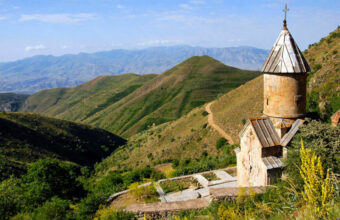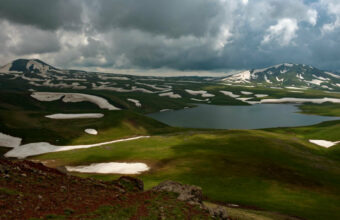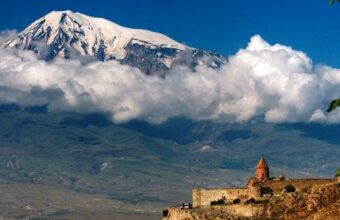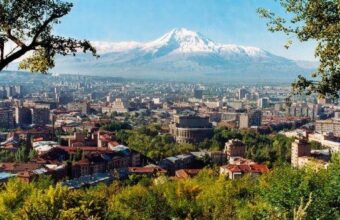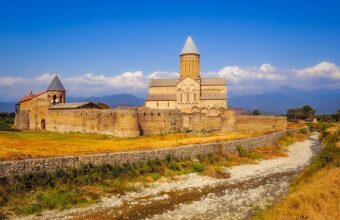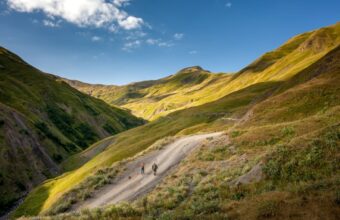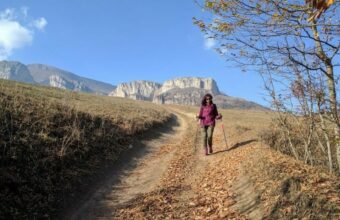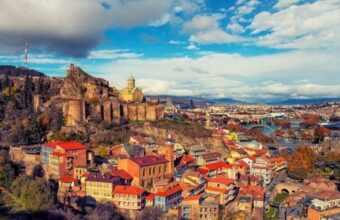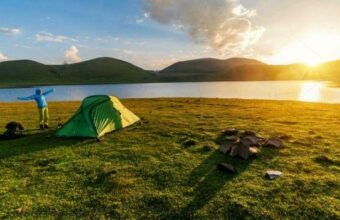Caucasus trekking & hiking
An expert guide to the best treks and hikes in the Caucasus mountains
With epic mountain landscapes that rival anywhere in Europe, fairytale villages, rolling hills and some truly excellent cuisine, the Caucasus mountains are one of the world's best – and most underrated – trekking and hiking destinations.
The Caucasus' trekking industry revolves mostly around Armenia and Georgia. Both countries are well set up for hiking tourism, have some stunning walking country and are well prepared for visitors. There are a good range of long-distance (inn-to-inn) hikes, as well as numerous places suitable for centre-based walking holidays.
Georgia is perhaps the best-known walking destination in the Caucasus, and has welcomed an influx of tourists in recent years. This is an excellent place to try out some long-distance routes, with high mountain peaks, splendid valleys and isolated stone villages. Look out for the many churches and monasteries that frame Georgia’s mountaintops.
Armenia is less about high peaks and more about day-hikes and easier routes. Dilijan National Park has several trails that can be hiked in a day, while the Tatev Monastery hike is almost unbelievably picturesque.
With fewer marked trails than either Georgia or Armenia and a less-developed hiking tourism industry, trekking in Azerbaijan isn't quite so easy. Head to Quba for trails between mountain villages – this is a place to experience the culture as much as the scenery.
Ready to go? Here's our essential guide to trekking in the Caucasus mountains.
The best Caucasus treks
Our expert's top picks
Unless you’re planning on hiking across the entire mountain range, you should expect a hike in the Caucasus to last anywhere from a single day to a couple of weeks. Most travellers opt for guide-led small group tours, with accommodation and essential logistics all pre-organised. Here are a handful of my favourite treks and hikes in the Caucasus Mountains.
-
Georgia
-
Armenia
-
Georgia
-
Dilijan National Park
-
Mount Aragats
-
Georgia
-
Georgia
-
Armenia
-
Armenia
-
Borjomi-Kharagauli National Park
Where to go trekking in the Caucasus
Our experts' top picks

Armenia
Dilijan National Park
Known as the ’Switzerland of Armenia,’ Dilijan National Park is a mountainous area covering 240 square kilometres with some of the best and most care-free hiking in the country.
You’ll find beech and oak forests populated with brown bears, wolves, deer and eagles as well as an abundance of fresh fruit including apricots and berries. The town of Dilijan is a wonderful place to recharge in between hikes with plenty of quality accommodation and delicious restaurants.
How to get to Dilijan National Park
You can take a marshrutka (minibus) from the Hyusisayin Avtokayan station in the north of Yerevan between 9am and 6pm. Minibuses leave when full and take about two hours to get to the central roundabout in Dilijan. The cost of the trip is about 1000 Armenian drams.
A taxi from Yerevan to Dilijan could cost up to 14,000 drams for the 100km journey.
When in Dilijan, there are plenty of taxis that can take you to surrounding towns or to your accommodation, though the town is quite small so it’s easy to walk around.
If you’d prefer to drive, there are several rental car agencies at the airport in Yerevan and it’s an easy drive along the M4 highway.

Georgia
Tusheti
Tusheti is one of the most stunning mountainous areas of Georgia, located just behind the main ridge of the Caucasus. Both areas are still unspoiled from tourists and commercial buildings due to poor roads, which also gives another charm to the whole trip.

Armenia
Tatev Monastery
Since as far back as the 9th century, Tatev Monastery in the south of Armenia has commanded a bold place overlooking one of Armenia's most epic sights, the Vorotan Gorge, which dips 800m beneath stark cliffs. The gorge is a sublime destination for day hikes with trails leading to tiny villages and important cultural sights.
How to get to Tatev
There are no marshrutky (minibuses) to Tatev or Halidzor from Yerevan, but you can take one to nearby Goris and then onto Tatev from there. Marshrutky leave Yerevan’s Sasuntsi Davit metro station for Goris at 9am and 4pm and take about six hours (2500 drams). From Goris, minibuses leave for Tatev at 8:30am and 3:30pm from the bus stop on Komitas St and take an hour.
There are shared taxis from Yerevan to Halidzor, but not to Tatev. Ask at your accommodation in Yerevan to have one pick you up. A private taxi from Goris should cost 8000 drams.
The drive from Yerevan is 250km and takes about five hours.

Georgia
Borjomi-Kharagauli National Park
This park is the first of its kind in Georgia to comply with international standards for national parks, meaning every trail is well marked apart and their are designated areas for tents, fires and picnic areas. Trekking here involves staying either at the tourist shelters or putting up a tent. It is possible to go hiking in Borjomi-Kharagauli National Park in every season except summer, as it gets far too hot.

Georgia
Ushguli
Ushguli, one of the highest settlements in Europe and a UNESCO World Heritage Site, boasts simply incredible scenery and a storied history. It can be reached via a two- to four-day hike from Mestia, one of the most popular treks in Georgia.

Armenia
Yeghegis Valley
Surrounded by huge peaks, charming villages, medieval churches and roaming animals, the Yeghegis Valley in Armenia’s Vayots Dzor province is excellent hiking territory. Don’t believe me? Take it from the Silk Road merchants who passed through here on their way to and from Western Europe and Asia. You can still find evidence of their journeys with a well-kept 14th-century caravanserai (shelter for weary travellers) in the Selim Pass. Summers in this region can get very hot at midday, so hiking between May and June or October and November is ideal.
How to get to the Yeghegis Valley
Buses leave Yerevan from the Sasuntsi Davit train station in the morning for Yeghegnadzor, the area’s main hub, and take about two hours (AMD1200). From there, you’ll need to take a taxi up to Artabuynk or the Selim caravanserai, which costs the standard AMD100 per kilometre rate.
A taxi from Yerevan to Yeghegnadzor costs about 15,000 drams and takes two and a half hours.
Driving is a good idea as there’s plenty to explore in the region but few buses to take you there. However, keep in mind that if you’re planning to do the Artabuynk to Yeghegis or Selim to Ughedzor hikes they aren’t loops, so you’ll have to find your way back to where your car is parked.

Armenia
Mount Aragats
Armenia’s borders might no longer contain Mount Ararat, the country’s national monument said to be where Noah’s ark first landed, but it does have Mount Aragats, a beautiful mountain in its own right and modern Armenia’s tallest peak. On Mount Aragats you’ll find waterfalls, sheep-covered valleys and pristine snow-capped mountains. To avoid the coldest temperatures, climbing is best between July and September, but don’t be surprised if there’s snow well into August.
How to get to Mount Aragats
There’s no public transport to Mount Aragats, so you’ll have to get to Kari Lake via taxi from Yerevan (about 10,000 drams) or by renting a car. The drive is 84km and takes about an hour and a half.
Many choose to get to Mount Aragats by hitchhiking, especially on weekends in the summer, but while hitchhiking is a popular way to get around in Armenia it's not recommended as it involves inherent dangers.

Azerbaijan
Gobustan National Park
An hour’s drive from Baku near the Caspian coast, Gobustan National Park’s mud volcanoes, mountains and rock art make it the perfect place to try a few day hikes.
Gobustan is probably best known for its mud volcanoes. More than half the world’s mud volcanoes are found in Azerbaijan, and Gobustan has more than its fair share. Mud volcanoes are actually more like mud geysers, with methane and carbon dioxide being released from the holes causing the mud to bubble and boil. The hot climate causes the mud to solidify rapidly, creating cracks and fissures in the floor.
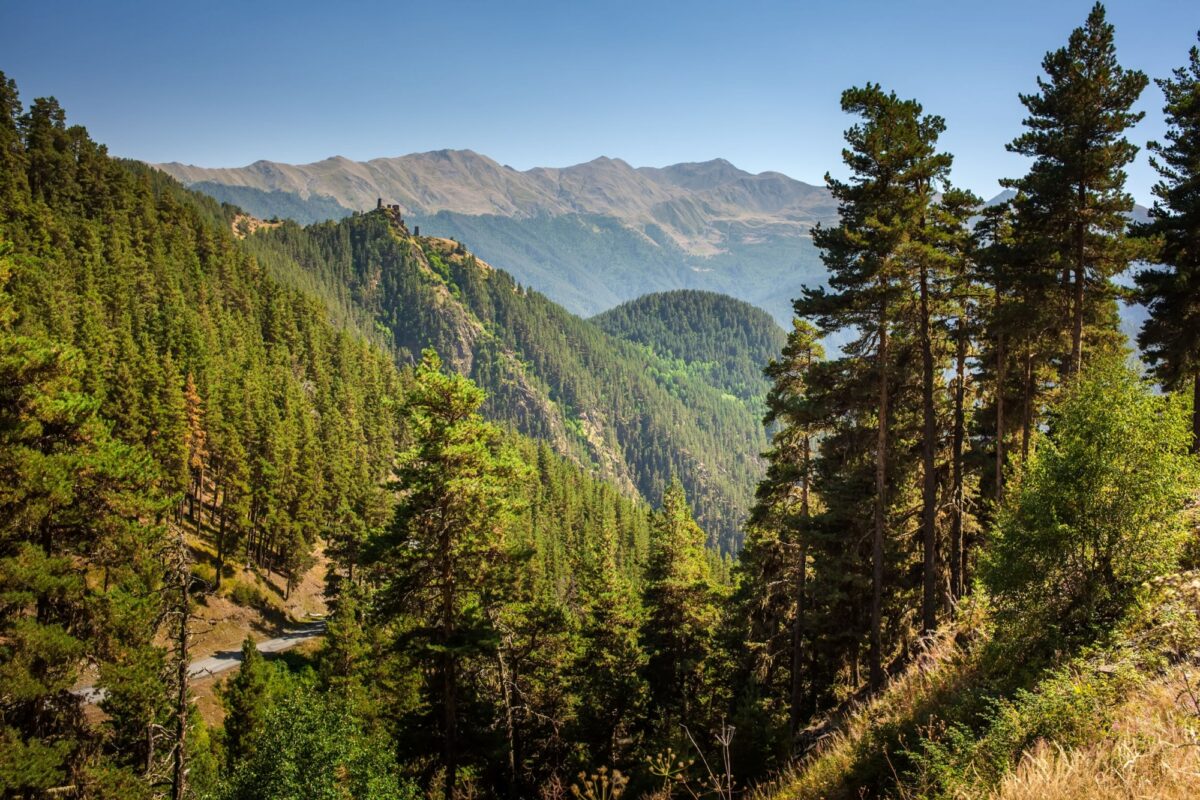
The forests of Tusheti, Georgia
Caucasus trekking: Need to know
Everything you wish you'd known before you booked
When to go trekking in the Caucasus
The weather in the Caucasus is at its most pleasant between June and September when you can expect warm and sunny weather. Temperatures can reach 25°C (77 °F), so make sure you pack appropriate hiking gear. It’s also important to bring mosquito nets and repellant, as the summer heat sees mosquitos descend on the region. The higher you get into the mountains, the less of a problem they will be.
Winter brings heavy snowfall to the Caucasus, making trails difficult to find and impossible to trek. It’s not uncommon for the snow to stay on higher ground until late April or even May, keeping higher routes closed off, even though the lowland is green and lush.
The best time to hike in the Caucasus region is from mid-June until the end of September. The high season is July and August, when the weather is dry and warm, whereas June and September are quieter but less reliable.
Hiking in the winter snow is not possible, but some tour companies do offer ski-touring, particularly in Georgia, which is also home to several ski resorts.
Independent trekking vs organised tours
Georgia is the Caucasus country most set up for independent hiking, with some well-marked trails, plenty of villages used to visitors and a burgeoning hiking community. The Svaneti region is particularly well-suited for independent visitors, with apartments available to rent in villages, lodges preparing lunches and breakfasts and signposted trails.
Beyond that, most independent treks take place in national parks, such as Armenia’s Dilijan National Park or Georgia’s Borjomi-Kharagauli.
Independent trekking has a lot going for it: It’s cheap(er) and can be a lot of fun. Trekking lodges—though far from luxurious—are often warmer and more comfortable than tents, and an increasing number now boast hot showers, varied menus and even wifi. There’s also the option of staying in local villages, although it is difficult to book ahead, so you’re often relying on the kindness of strangers.
The biggest advantage of independent trekking is the ability to change your itinerary as you see fit. If you stay in a village and like the feel of it, you can stay for a few days. If you hear about a side trek or different route you want to try out, you can. However, this positive can also be a negative. Attempt an unusual or unmarked route, and you can end up in the middle of nowhere without a place to sleep. Trying to book accommodation in advance can be tedious and difficult. Language difficulties mean you might spend most of the trip on your own, unable to interact with the people you meet.
Organised Caucasus treks
An organised trek doesn’t have to mean a package tour-style trip with coaches and loads of people. In fact, an organised trek can involve just yourself and a guide, taking off across the Caucasus mountains.
Mostly, an organised trek will involve several hikers of varying degrees of fitness and expertise alongside a couple of guides and potentially a porter, depending on whether you’re doing a multi-day or single day hike.
A fully organised trek comes with the benefits of having your accommodation booked in advance each night. Your guide will know the best places to stop for the night and where you can eat, as well as introducing you to locals and explaining the history and geography of the places you’ll see.
An organised trek also means security. Your guide will know the route and any problems up ahead that independent trekkers would not. They’ll also be able to act as a cultural and language translator, meaning your interactions with locals will be more authentic. Finally, having someone book your accommodation along the way means that you won’t have to carry extra equipment or camping gear (note that it is possible to mix up homestays/village accommodation with an occasional wild camping experience).

